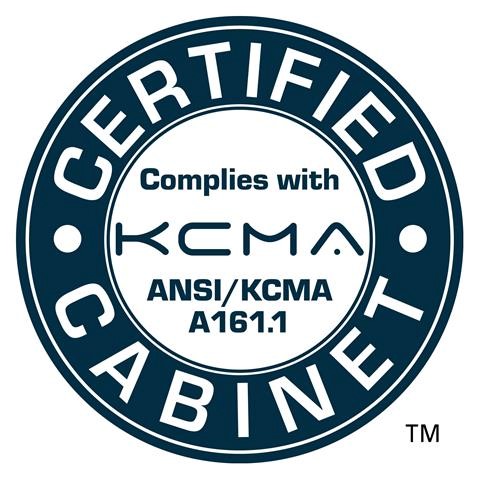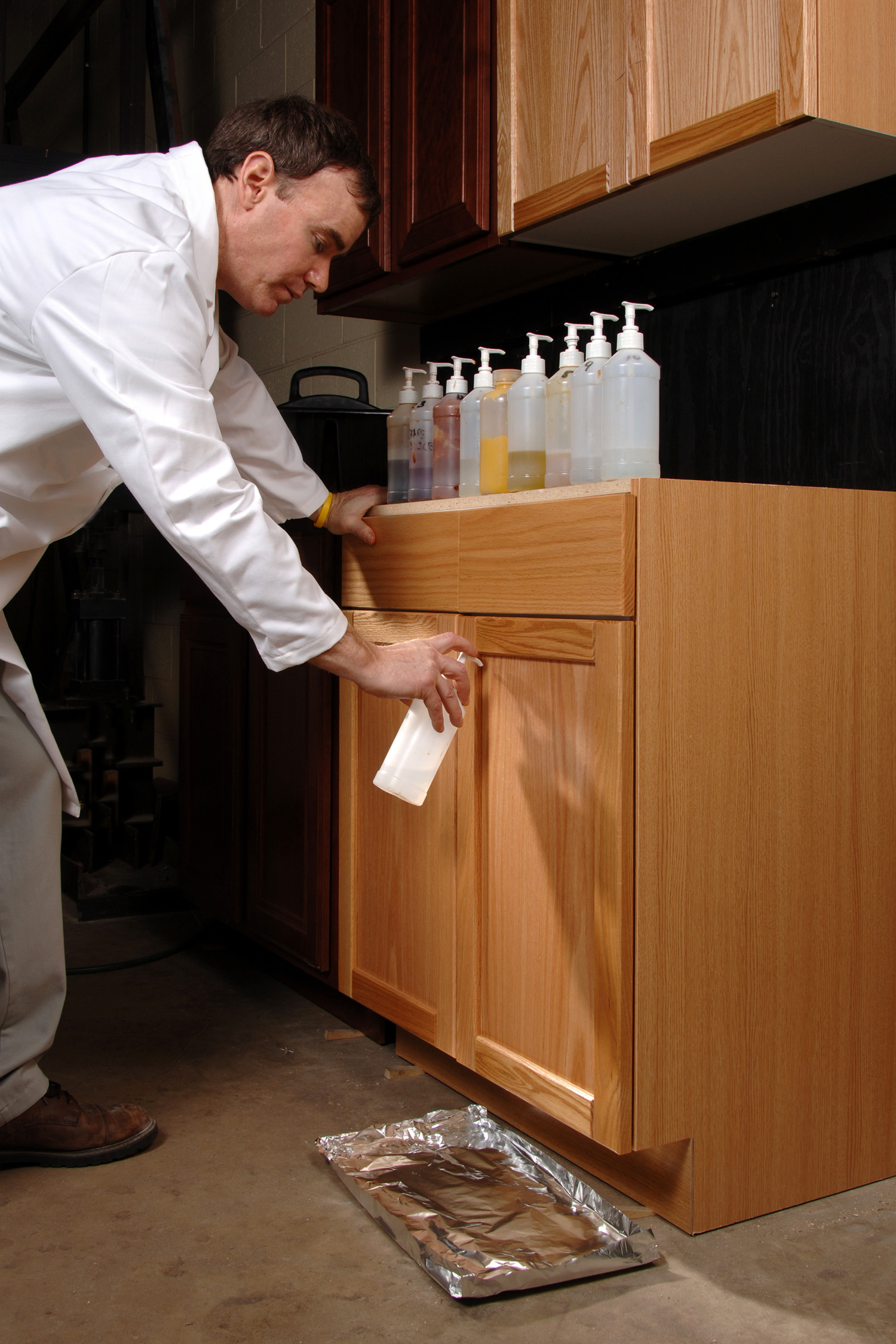Consumers, dealers and manufacturers have all come to know that products bearing the ANSI/KCMA Certified seal meet rigorous performance and construction requirements, including testing for weight, slide, swing and stain. The Kitchen Cabinet Manufacturers Association administers the ANSI/KCMA A161.1-2017 Performance & Construction Standard for Kitchen and Vanity Cabinets.
“The KCMA A161.1 standard is unique in that it is the only performance standard for kitchen and bath cabinets,” said Chuck Arnold, director of certification.
To be certified, cabinetry must first meet the following 14 construction requirements:
• Cabinets must be fully enclosed, with backs, bottoms, sides and tops (wall cabinets); and backs, bottoms and sides (base cabinets). The exceptions are sink fronts and bases, oven cabinets and refrigerator cabinets.
• Floor cabinets must have a toe space at least 2 inches deep and 3 inches high.
• Utility cabinets must meet the same construction requirements as base and wall cabinets.
• Doors and drawers must be properly aligned, have means of closure, and close without excessive binding or looseness.
• All materials must ensure rigidity in compliance with the performance standards.
• Face frames, when used, must provide rigid construction.
• For frameless cabinets, the ends, tops/bottoms, and back must have the thickness necessary to provide rigid construction.
• Corner or lineal bracing must be provided at points where necessary to ensure rigidity and proper joining of various components.
• All wood parts must be dried to a moisture content of 10 percent or less at the time of fabrication.
• All materials used in cabinets must be suitable for use in the kitchen and bath, where they may be exposed to grease, solvents, water, detergent, steam and other substances usually found in these rooms.

• All exterior exposed surfaces and edges, except the edges of end panels and the edges of back panels, should be free of saw marks and other imperfections. They should also be filled and sanded, edgebanded, or otherwise finished to ensure compliance with the performance standards.
• All exterior exposed parts of cabinets must have nails and staples set and holes filled.
• All exposed construction joints must be fitted in a workman-like manner consistent with the specifications.
• Exposed cabinet hardware must comply with Builders Hardware Manufacturing Association finishing standards.
In order to be certified, cabinets must also undergo eight categories of testing, covering structural integrity, drawer and door operation and finish quality (see sidebar below). Accredited independent laboratories are used to perform the KCMA A161.1 testing in support of the certification.
“Independent, third-party testing by accredited laboratories is the cornerstone of the certification program. They provide unbiased test results assuring the cabinet lines on the manufacturer’s Listing Certificate comply with the KCMA A161.1 standard,” Arnold said.
KCMA’s certification program is open to all cabinet manufacturers, with an option to certify one, several, or all of their cabinet lines. The certified lines are listed in the online KCMA Directory of Certified Cabinet Manufacturers and on each Listing Certificate. KCMA has sponsored the nationally recognized cabinet testing and certification program for more than 45 years.
An accredited standard developer, KCMA continues to revise and strengthen its standards under strict ANSI guidelines. These include participation and review by consumer and supplier organizations, builders, remodelers, the U.S. government, architects, and other related groups to ensure the standard reflects current improvements in technology, materials and construction. KCMA recently revised the 2012 version of the KCMA A161.1 standard and is using the 2017 version for certification.
“Periodic revision of a standard by a balanced committee representing all interested parties ensures the standard remains up to date with changes in manufacturing processes and materials,” Arnold explained.

Categories for testing
Cabinets bearing the ANSI/KCMA 161.1 certification seal have been extensively tested under rules set by the American National Standards Institute and by a consensus committee administered by the Kitchen Cabinet Manufacturers Association. ANSI/KCMA A161.1 includes tests for structural integrity, drawer and door operation and finish quality.
Structural tests: These verify the structural integrity and strength of the cabinets. On all cabinets, the shelves and bottoms are loaded at 15 pounds per square foot, with the weight maintained for seven days to ensure that there is no excessive deflection and no visible sign of joint separation or failure of any part of the cabinets or the mounting system. In addition, mounted wall cabinets are gradually loaded to 600 pounds to ensure no visible sign of failure in the cabinet or the mounting system.
To test the strength of base-front joints, a load of 250 pounds is applied against the inside of cabinet-front stiles for cabinets with a drawer rail, or 200 pounds for cabinets without a drawer rail, to ensure reliable front joints that will not open during stress in service or during installation.
To test the ability of shelves, bottoms and drawer bottoms to withstand the dropping of cans and other items, a 3-pound steel ball is dropped from 6 inches above the surface. After the test the drawer must not be damaged and must operate as before the test, with no visible sign of joint separation or failure of any part of the cabinet or mounting system.
To test the ability of cabinet doors and connections to withstand impacts such as children may cause in falling against a cabinet, or running into it with a tricycle, a 10-pound sandbag is used to strike the center of a closed cabinet door and repeated with the door opened to a 45-degree angle. The cabinet door must operate as before the test and show no damage or sign of separation or failure in the system.
Drawer tests: To test the ability of drawers and drawer mechanisms to operate with loading during normal use, drawers are loaded at 15 pounds per square foot and operated through 25,000 cycles. The drawers must then remain operable with no failure in any part of the drawer assembly or operating system, and drawer bottoms must not be deflected to interfere with drawer operation.
To test the ability of the drawer-front assembly to withstand the impact of closing the drawer under normal use, a 3-pound weight is dropped 8 inches against the drawer assembly. After 10 drops, there must be no evidence of looseness or structural damage to the drawer-front assembly that impairs its operation.
KCMA’s certification program is open to all cabinet manufacturers, with an option to certify one, several, or all of their cabinet lines.
Door Operation Tests: To test the ability of doors, hinges, and means of attachment to withstand loading, 65 pounds of weight is applied on the door. The weighted door is slowly operated for 10 cycles from 90 degrees open to 20 degrees open, and returned to the 90-degree position. The door must remain weighted for 10 minutes, after which the door and hinges must show no visible signs of damage, and connections between cabinet-and-hinge and door-and-hinge must show no sign of looseness.
To test the ability of doors, door-holding devices, hinges and attachment devices to operate under the stress of normal use, doors are opened and closed through a full 90-degree swing for 25,000 cycles. At the test’s conclusion, the door must be operable, the door-holding device must hold the door in closed position, hinges must show no visible signs of damage, connections between cabinet-and-hinge and door-and-hinge must show no sign of looseness, and other specifications must be met.
Finish Tests: These tests create, in accelerated form, the cumulative effects of years of normal kitchen conditions of pre-finished cabinets. Cabinet finishes are inspected to ensure that stringent standards of appearance are also met.
To test the ability of the finish to withstand high heat, a cabinet door is placed in a hotbox at 120F and 70 percent relative humidity for 24 hours. The cabinet’s finish must show no appreciable discoloration and no evidence of blistering, checks, or other film failures.
To test the ability of the finish to withstand hot and cold cycles for prolonged periods, a cabinet door is placed in a hotbox at 120F and 70 percent relative humidity for one hour, removed and allowed to return to room temperature and humidity conditions, and then placed in a coldbox for one hour at -5F. The cycle is repeated five times. The finish must then show no appreciable discoloration and no evidence of blistering, cold checking, or other film failure.
To test the ability of the finish to withstand substances typically found in the kitchen and bath, exterior exposed surfaces of doors, front frames, drawer fronts and end panels are subjected to vinegar, lemon, orange and grape juices, tomato catsup, coffee, olive oil, and 100-proof alcohol for 24 hours and to mustard for one hour. After this test, the cabinet’s finish must show no appreciable discoloration, stain, or whitening that will not disperse with ordinary polishing and no indication of blistering, checks, or other film failure.
To test the ability of the finish to withstand long periods of exposure to a detergent and water solution, a cabinet door edge is subjected to exposure to a standardized detergent formula for 24 hours. The door edge must then show no delamination or swelling and no appreciable discoloration or evidence of blistering, checking, whitening, or other film failure.
For additional information on the ANSI/KCMA A161.1 performance standard or inquiries regarding certification training, contact Chuck Arnold [email protected].







Have something to say? Share your thoughts with us in the comments below.